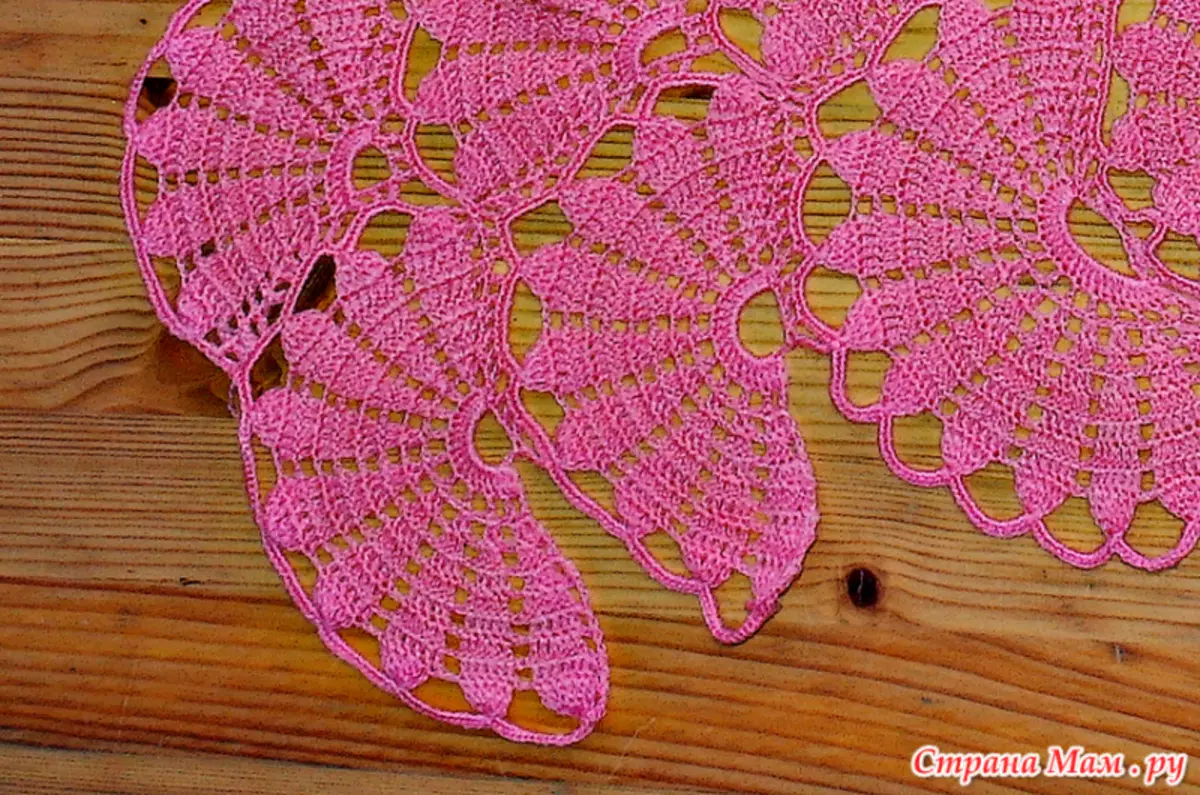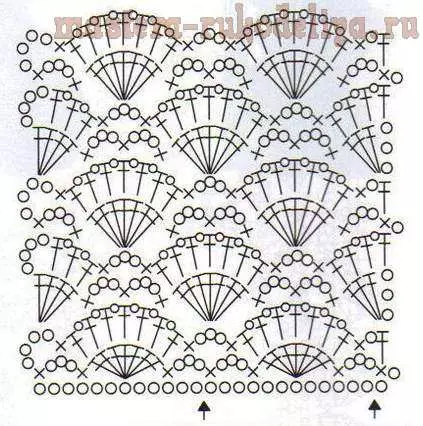Crocheted patterns in the form of a fan of many are associated exclusively with round napkins, which serve only for the decoration of the apartment. However, in this technique you can create unique women's clothing - from the tops and bolero to the exquisite skirts and dresses. Despite the fact that there are traditional patterns of the pattern, the "fan" crochet can be associated in such a way that the finished piece of clothing will not have anything in common with the products in the household. "Waiter" in this case are similar to what they fit in a circle, but form a smooth canvas, for the density of which the elements of the picture are located in a checker order.


Simple option
The main rule when knitting the "Fan" pattern is strictly compliance with cyclicity. The drawing looks noble with maximum accuracy and accuracy, taking into account the painstaking of work, passing a single loop can lead to asymmetry of the entire product.Starting acquaintance with this technique is recommended from simple vera variants, for example, you can connect the pattern submitted in this video:
A number of air loops are tied as the basis of the product, and after that, two more rows from the columns with one Nakud. "Waiter" appear only in the fourth row.
The fourth row begins with two air loops (lifting). In the base of the lift, two columns with two nakids should be tied. Thus, the middle of the fourth will be with the edge, which will add a product of accuracy and make it easy to bore it.
"Water" will be held in every sixth loop from the start of work, each of them will consist of six columns that are located as follows. First, three columns with two nakids should be born into the right loop. After that, the air loop is followed, which connects the vertices of two beams from the columns forming the "fan". Further, three more columns also knit with two nakids, the base of which is the same loop as when knitting the previous beam. One "fan" is ready. Knit them continue to the end of a row, which should also be completed half the "Waiter".
Article on the topic: Circuit rugs with cord and from packages with description and photo
Then the product should be turned over and continue knitting in a similar way, using air hinges in the bottom row to base "fans".
High "Waiter"
Please note that the more loops are used to knit a fan, the more exquisite it seems the finished product.
Detailed study of the elements that leaves the opportunity for free creativity, gives wine resemblance to lace.

Dresses from such fans seem easy and romantic, however, for use in the design of such items, the pattern requires a certain density. Among the corresponding descriptions - the pattern of the pattern, the knitting scheme is explained in the following video:
The rapport of the presented pattern is three rows of 12 loops. It begins knitting from the column without a Nakid, which must be attached to the second loop in the chain that serves as the basis. Next is the connecting element of three air loops. Then you need to skip two more loops and attach to the third column without Nakid. Thus, conditionally half of the "Veter", which is needed for the symmetry of the pattern. Then you should retreat two loops and proceed to knitting already a whole "Water".
To do this, you already have seven columns with Nakad in the same loop. It is attached to the base without a Nakid, which fit with the same indent in two loops. The connecting elements of this ornament are a chain of air loops, three each. You need to dial three air hinges twice and attach them, again the column without a nakid, having missed two more hinges. This rapeport is completed and you can proceed to knitting the next fuel.
In the next row, the fan should expand, so it is knotted using not only columns, but also air loops. First of all, it is necessary to connect the connecting chain (in three air loops), it is attached to the bottom row (by the middle of the chain) using a column without a Nakid. Seven columns without Nakid are tied on the fan, each of them is separated from the previous one air loop. The extreme left post is also attached to the middle of the chain (from air loops) in the lower row. Thus, there is only one chain between versions in this row. At the end of the second row, on the extreme chain you need to tie one column without Nakid, followed by one air loop, as well as a semi-solol without a nakid.
Article on the topic: Sabrina magazine №12 2019
In the next third, a row of a fan must be shifted in a checker. Initially, the connecting chain of three air loops fit - in this case, it will mimic one of the parts of the fan. The first fan in this row fit only half, it should consist of four columns. Therefore, on the last air loop, which the lower row ended, you need to check only three columns with Nakud. Then there are two chains (3 air loops, as before). The first is attached by a column without a nakid to the loop, which is located between the second and third column of the fan in the second row. The next is attached to the central column of the same place. Further, the whale knit the same way as in the first row. Complete the series you need half a fan - of four columns. On this rapport pattern ends.

Fantasy option
There are many fantasy varieties of patterns that allow knitting openwork and dense canvases, climb into a fan of butterflies, lumps, flowers and more. Experimenting with this pattern, you can connect openwork flying skirts and bolero or dresses that will look more strictly and keep shape. It seems to look at the gradient or contrasting border, which can be used to design the edges of the product, focusing individual elements.


Visually, this drawing is similar to another popular pattern - "shells". However, its important difference is the use of tensions for knitting, and sometimes air loops, so that the finished canvas turns out openwork and with a minimum volume. "Sheckers" suggest the use of beams of long loops, which are somewhat more complicated in knitting, and also guarantee the relief of the pattern. Therefore, "Veter" is better to use to create summer things, and "shells" - for knitting from thick yarn.
Video on the topic
Article on the topic: how to make yarn from packages
